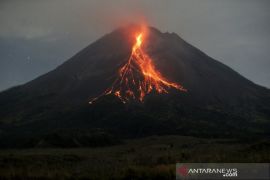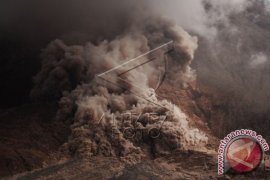Until Sunday at 5:30 p.m. local time, the Center of Data and Information (Pusdatin) of the National Disaster Mitigation Agency (BNPB) had reported that 5,205 people were impacted by the hot cloud and volcanic ash, out of which 14 were declared dead.
Among the deceased were two from Supiturang Village, five at Dr. Haryoto Hospital, five unidentified bodies at Bhayangkara Hospital, and two others at Sumberwuluh Village, Head of BNPB Pusdatin Abdul Muhari informed the press here on Sunday afternoon.
The volcanic disaster had compelled 1,300 residents to evacuate to four posts located in the sub-districts of Pronojowo and Candipuro.
Meanwhile, BNPB's Control and Operational Center had reported that the burning cloud or "pyroclastic flow" and some of Semeru's volcanic ashes that flew at an altitude of 50 thousand feet had injured 56 people, out of which 35 were severely hurt.
Eight were receiving treatment at Haryoto Hospital, 16 at Bhayangkara Hospital, and eight at Penanggal Health Center, while 21 people suffered mild injuries.
Muhari remarked that as of Dec 6, 11:00 a.m. local time, some nine people were either declared lost or dead.
Most of the severely injured victims suffered from burns, and specific treatment from a specialist was deemed necessary for them, Health Ministry's Crisis Center head, Eka Jusuf Singka, remarked. "Patients with burn wounds need to be evacuated to a hospital that meets the requirements," he explained.
Patients with burn wounds, especially those with severity above 20 percent, can be rushed to five referral hospitals in Lumajang District. A local health office also noted that some hospitals from Surabaya and Malang had helped to further increase the capacity for patients.
Singka noted that the treatments for patients with burns involved doctors from the Indonesian Surgeons Association, Indonesian Medical Association, Indonesian Red Cross, and non-governmental organizations in the health sector.
Burns
Head of the Indonesian Plastic Surgery Association Dr. Najat pointed out that burns are classified based on their size and depth. Minor burns, such as incidents of being doused with hot water or oil spills, require no hospital treatment as pain relief ointment only has to be applied to the patients.
However, burns, of the moderate to critical category, need special treatment. For instance, 20 percent burns in adults or 10 percent in children.
"The depth of the burn on the skin is of varying degrees that show the damage caused to the skin tissue," he told ANTARA.
According to Najat, the higher the temperature is and the longer the skin is exposed to heat, greater is the severity of the burn.
As a result of Mount Semeru's eruption, most victims had to inhale volcanic ash or the burning cloud that affected the respiratory tracts. Such condition might have caused swelling of the airways, thereby triggering breathing difficulties among the victims, he stated.
Najat attributed the death toll in the Semeru eruption to heat inhalation that interfered with the respiratory path. According to Najat, this condition can quickly kill someone.
"If the airway is blocked, in a matter of seconds, the patient is already dead," he explained.
Other symptoms of breathing difficulties are fluid-related problems in the blood vessels when the burned body swells or enters a state of shock.
"The treatment of providing oxygen and liquid for shock and breathing difficulties is the first phase. If it is handled, then we take care of the burns," he explained.
During the phase of treating burns, Najat stated that the damaged tissue should be sanitized. Surgery, such as skin grafting only to be performed by plastic surgeons, is the line of treatment for disfigured skin.
The process of healing burns is based on the severity classification, he noted.
"If it is too serious, the (patient) may not survive. Even if he or she recovers, there is a likelihood of skin defects," he highlighted.
He also pointed to several barriers in the recovery process, as the process of skin grafting took about a month. Moreover, obstacles in the form of the patients' comorbidity can hinder the healing process.
Impacts on human health
Burning clouds and volcanic ash of high intensity can likely trigger broader health problems among members of the public in the absence of requisite precautionary measures.
University of Indonesia's Faculty of Medicine Professor, Tjandra Yoga Aditama, has informed that hot clouds firstly arise as a result of the volcanic eruption that directly impacts the body, in addition to hot and cold lava.
Concurrently, volcanic gas and ash can irritate the human skin, eyes, and respiratory system. A health authority once diagnosed a victim with minor burns at above 50 percent.
Generally, the victims were residents, who were unable to save themselves on time and got trapped in the volcanic materials.
"The inhaled hot clouds can cause inhalation trauma that requires bronchoscopy," he explained. Furthermore, he stated that the victims can suffer from injuries, such as fractures and internal wounds.
Aditama, concurrently a lung professor, drew attention to six concerning diseases following a volcanic eruption, as they can increase the number of sickly residents.
The six diseases are Acute Respiratory Infection (ARI); Lower Respiratory Tract Infections (pneumonia and bronchitis); inflammation, infection, and irritation on skin and eyes; digestive tract disorders; worsening chronic disease; and depleting body immunity due to stress and lack of prescribed drug consumption.
Aditama explained that to avoid such conditions, people should apply seven approaches. First, for regions that are impacted by volcanic ash, residents should not venture out or also evacuate if not necessary.
If left with no choice but to head out, people should wear a mask and cover or close water facilities, such as opened wells and reserves, to prevent contact with ash. Furthermore, he reminded to clean all food, fruits, and vegetables. Subsequently, the impacted residents should seek treatment at health centers if they experience coughing, breathing difficulties, and eye and skin irritations.
People ailing from chronic diseases must diligently consume their prescribed drugs on a routine basis. According to Aditama, these people must lead a healthy and hygienic lifestyle both at home and at the evacuation shelter.
This nation is sentient of the victims of the Mount Semeru eruption. Preventive mitigatory efforts against another eruption should be made against broader sicknesses due to exposure to burning clouds and volcanic ash.
To this end, all victims can receive help from health workers and related agencies.
Related news: KAI distributes aid for victims of Mount Semeru's eruption
Related news: Gov't should prioritize needs of eruption-affected residents: House
Related news: ESDM Ministry supports recovery at Mt Semeru eruption-affected areas
Editor: Rahmad Nasution
Copyright © ANTARA 2021











